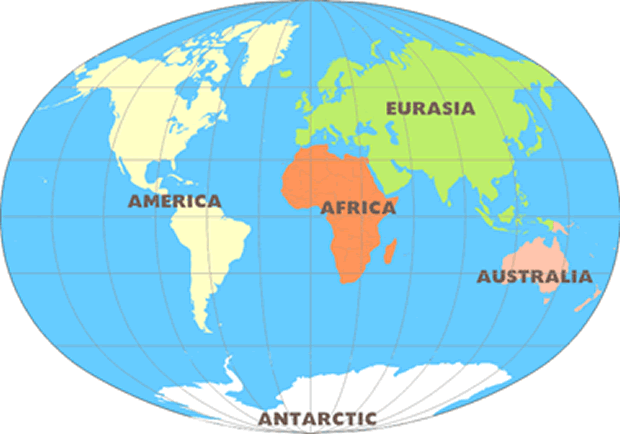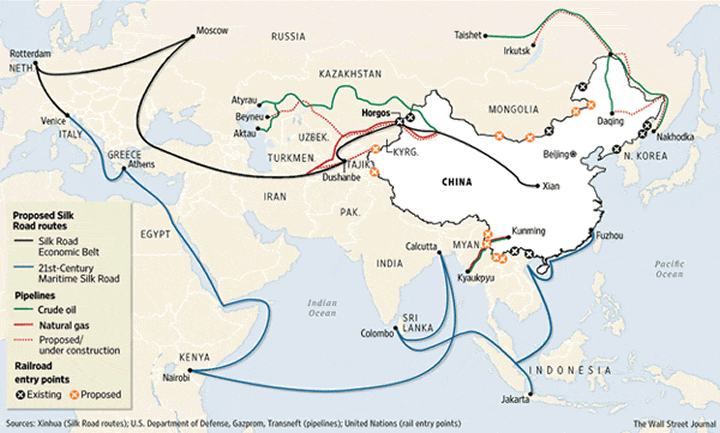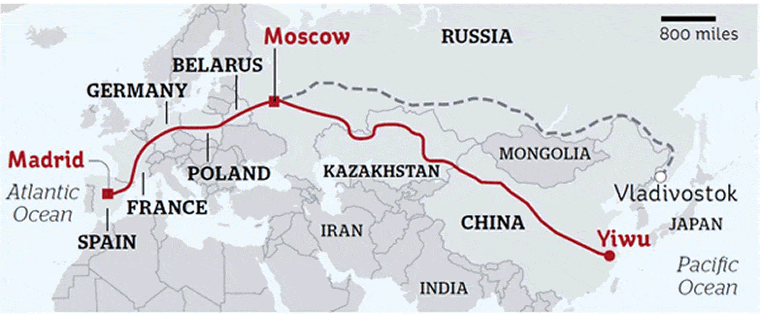The Most Important Geopolitical Trend of the Next Decade…Here’s How to Profit
Politics / GeoPolitics Sep 08, 2015 - 03:13 PM GMTBy: Casey_Research
 By Nick Giambruno
By Nick Giambruno
The bloodbath was merciless.
In 1842, 16,500 British soldiers and civilians withdrew from Kabul, Afghanistan. Only one would survive.
It was the most humiliating military disaster in British history. The death toll sealed Afghanistan’s reputation as “the graveyard of empires.”
It was the desire for control of Central Asia that sucked the British Army into its Afghan disaster.
For most of the 1800s, the UK and Russia pushed for power and influence in Central Asia in a competition known as “the Great Game.”
It wasn’t just to score points. The thought of losing India terrified the Brits more than anything else. India had huge economic resources, a plentiful supply of military-aged males, and strategic geography. London treasured India as “the jewel in the crown of the British Empire.”
To the Brits, the expansion of the Russian Empire into Central Asia was a threat to their control of India. Neighboring Afghanistan was their red line. If the Russians could draw Afghanistan into their sphere of influence, they would become an intolerable threat to British India.
So, in 1839, the British Army invaded. They installed a puppet regime in Kabul that would stand as a buffer to Russian influence.
Every previous attempt to bring Afghanistan under foreign rule had ended badly. The Afghans are some of the toughest and most stubborn fighters in the world. The British knew that executing their plan wouldn’t be a cakewalk.
After a few years of trying and then failing to impose their will, the Brits threw in the towel.
Early in 1842, 16,500 British soldiers and civilians packed up and left Kabul. As they fled through the mountainous trails, Afghan tribal fighters attacked repeatedly.
It added up to an epic massacre…
If the Afghan fighters didn’t kill you, disease and winter weather would.
After just seven days, only one man was still alive. William Brydon was bloody, torn, and exhausted. He was the only one to make it to the nearest British military outpost. That outpost was in Jalalabad, 90 miles away from Kabul. The Afghans let him live so there would be someone to tell the grisly story.
The garrison in Jalalabad lit signal fires to guide other British survivors to safety. After several days, they realized no one was left to see the light.
Painter Elizabeth Butler captured the pain and desperation of the moment in her Remnants of an Army, below.
The debacle was a brutal lesson in geopolitics: geography constrains the destiny of nations and empires. Ignore that constraint at your peril.
Despite their folly in Afghanistan, the British were generally shrewd players in geopolitics. It was a skill developed from a centuries-long career as an imperial power.
The godfather of geopolitical theory was British strategist Sir Halford Mackinder. Mackinder developed a general theory that connected geography with global power. To this day, planners in the US, Russia, and China study his teachings.
Mackinder argued that dominating the Eurasian landmass - Asia and Europe together - was the key to being the leading global power.

http://www.freeworldmaps.net/continents/
Zbigniew Brzezinski, the renowned American geopolitical strategist, echoes Mackinder on the importance of Eurasia in his book The Grand Chessboard: American Primacy and Its Geostrategic Imperatives:
Ever since the continents started interacting politically, some five hundred years ago, Eurasia has been the center of world power. A power that dominates “Eurasia” would control two of the world’s three most advanced and economically productive regions…rendering the Western Hemisphere and Oceania geopolitically peripheral to the world’s central continent. About 75% of the world’s people live in “Eurasia,” and most of the world’s physical wealth is there as well, both in its enterprises and underneath its soil. “Eurasia” accounts for about three-fourths of the world’s known energy resources.
A single power that controls the resources of Eurasia would be an unstoppable global superpower.
If one couldn’t control all of Eurasia, the next best thing would be to dominate the world’s oceans. Control of the sea lanes means control of international trade and the flow of strategic commodities.
In 1900, the British Empire was near the peak of its strength. It was the world’s undisputed naval power. Its naval bases ringed Eurasia from the North Atlantic to the Mediterranean, from the Persian Gulf to the Indian Ocean, all the way to Hong Kong. This enabled the Brits to project event-shaping military power into Eurasia.
Today, the US is far and away the world’s leading naval power. Like the British before them, the Americans have followed the geopolitical strategy of ringing Eurasia with military bases and exploiting its divisions.
The aircraft carrier, with its 5,000-person crew, is the central instrument of US naval power. Putting just one of these enormous vessels into operation costs more than $25 billion.
The US Navy has 11 carriers, more than the rest of the world combined. And it’s not just ahead in quantity. The power and technological sophistication of US aircraft carriers are far beyond the capabilities of any competitor. There is simply no military force now or in the foreseeable future that could dispute US control of the high seas.
Soon, though, it may not matter.
That’s because China, Russia, and others are working on an ambitious plan. They seek to make US dominance of the seas unimportant. They’re tying Eurasia together with a web of land-based transport facilities. A constellation of supporting organizations for financial, political, and security cooperation is also in the works. If they’re successful, they’ll wipe away hundreds of years of geopolitical strategic thinking. They’ll make the current US planning paradigm obsolete. They’ll undermine the strategy that the US - and the UK before it - has relied on to dominate geopolitics. It would be the biggest shift in the global power balance since WWII.
It’s a game for the highest stakes…a real-life battle of Risk. The effort and countereffort to integrate Eurasia is the new Great Game. It’s the most important process to watch for the next 10 years.
The central project to integrate Eurasia is the New Silk Road.
The World’s Most Ambitious Infrastructure Project
For over a thousand years, the Silk Road, named for the lucrative trade it carried, was the world’s most important land route.
At 4,000 miles long, it passed through a chain of empires and civilizations and connected China to Europe. It was the path along which merchant Marco Polo traveled to the Orient. When he returned, he gave Europeans their first contemporary glimpse of China.
Today, China is planning to revive the Silk Road with modern transit corridors. This includes high-speed rail lines, modern highways, fiber-optic cables, energy pipelines, seaports, and airports. They will link the Atlantic shores of Europe with the Pacific shores of Asia. It’s an almost unbelievable goal.
If all goes according to plan, it will be a reality by 2025. A train from Beijing would reach London in only two days.
New Silk Road Routes

The New Silk Road is history’s biggest infrastructure project. It aims to completely redraw the world economic map. And, if completed, it has the potential to be the biggest geopolitical game-changer in hundreds of years.
Tying Eurasia together with land routes frees it from dependence on maritime transport. That ends the importance of controlling the high seas. That reshapes the fundamentals of global power…and it’s exactly what the Chinese and Russians want.
In late 2013, Chinese president Xi Jinping announced the New Silk Road. The Chinese government rules by consensus. They’re careful long-term planners. When they make a strategic decision of this magnitude, you know they are totally committed. They have the political will to pull it off. They also have the financial, technological, and physical resources to do it.
The plan is still in the early stages, but important pieces are already falling into place. On November 18 of last year, a train carrying containerized goods left Yiwu, China. It arrived in Madrid, Spain, 21 days later. It was the first shipment across Eurasia on the Yiwu-Madrid route, which is now the longest train route in the world. It’s one of the first components of the New Silk Road.

As ambitious as the New Silk Road is, it’s just one aspect of the integration of Eurasia.
In just the past year, a set of interlocking international organizations has emerged. These new linkages are the institutional support for a new political-economic-financial order in Eurasia.
Here are the most prominent organizations…
Asian Infrastructure Investment Bank (AIIB)
China launched the AIIB in 2014 with financing for New Silk Road projects in mind. Its initial capital base is more than $100 billion.
The AIIB would be a Eurasian alternative to the US-dominated International Monetary Fund (IMF) and World Bank. Those institutions have been standing atop the international financial system. China, Russia, and India are the main shareholders and decision makers at the AIIB.
Nearly 60 countries, mostly in Eurasia, have signed up to join the bank. Japan and the US declined to join. Then, the US government embarrassed itself by trying (and failing) to pressure allies the UK, France, and Germany into snubbing the organization.
BRICS and the New Development Bank (NDB)
The BRICS countries - Brazil, Russia, India, China, and South Africa - are all onboard for Eurasian integration. The NDB, like the AIIB, is an international financial institution headquartered in China (but headed by an Indian banker), with $100 billion in capital. Also like the AIIB, the NDB is an alternative to the IMF and World Bank. The BRICS countries established the NDB in July 2015.
The NDB and AIIB will complement, not compete with, each other in financing the integration of Eurasia. The NDB will also finance infrastructure projects in Africa and South America.
The NDB will use members’ national currencies, bypassing the US dollar. It won’t depend on US-controlled institutions for anything. That reduces the NDB’s exposure to US pressure.
The BRICS countries are also exploring building an alternative to SWIFT, an international payments network.
SWIFT is truly integral to the current international financial system. Without it, it’s nearly impossible to transfer money from a bank in country A to a bank in country B.
In 2012, the US was able to kick Iran out of SWIFT. That crippled Iran’s ability to trade internationally. It also demonstrated that SWIFT had become a US political weapon. Neutralizing that kind of power is precisely why the BRICS countries want their own international payments system.
Eurasian Economic Union (EEU)
The EEU is a Russian-led trading bloc. It opened for business in January 2015. The EEU provides free movement of goods, services, money, and people through Russia, Belarus, Kazakhstan, Kyrgyzstan, and Armenia. Other countries may join.
Trade discussions have started with India, Vietnam, and Iran. The EEU is gradually expanding as countries along the New Silk Road remove barriers to trade. Egypt, Argentina, Brazil, Paraguay, Uruguay, and Venezuela are also in trade talks with the EEU.
Shanghai Cooperation Organization (SCO)
In the military and security realm, there’s the SCO. Current members include China, Kazakhstan, Kyrgyzstan, Russia, Tajikistan, and Uzbekistan. India and Pakistan will join by 2016. Iran is also likely to join in the future.
Putting the Pieces Together
Eurasian integration, and the US attempt to block it, will be the most important story for the next 10 years. This is the new Great Game.
Oddly, the US media has barely made a peep about it. Maybe the story of Eurasian integration is just too big and complex to fit into sound bites.
The New Silk Road…the Asian Infrastructure Investment Bank…the BRICS New Development Bank…an alternative SWIFT system…the Eurasian Economic Union…the Shanghai Cooperation Organization…these are the building blocks for a new world.
There could be huge profits for investors who position themselves correctly ahead of this monumental trend.
There is an easy way for US investors to tap into this trend. Click here to get the latest issue of Crisis Speculator for all the details.
Casey Research Archive |
© 2005-2022 http://www.MarketOracle.co.uk - The Market Oracle is a FREE Daily Financial Markets Analysis & Forecasting online publication.



